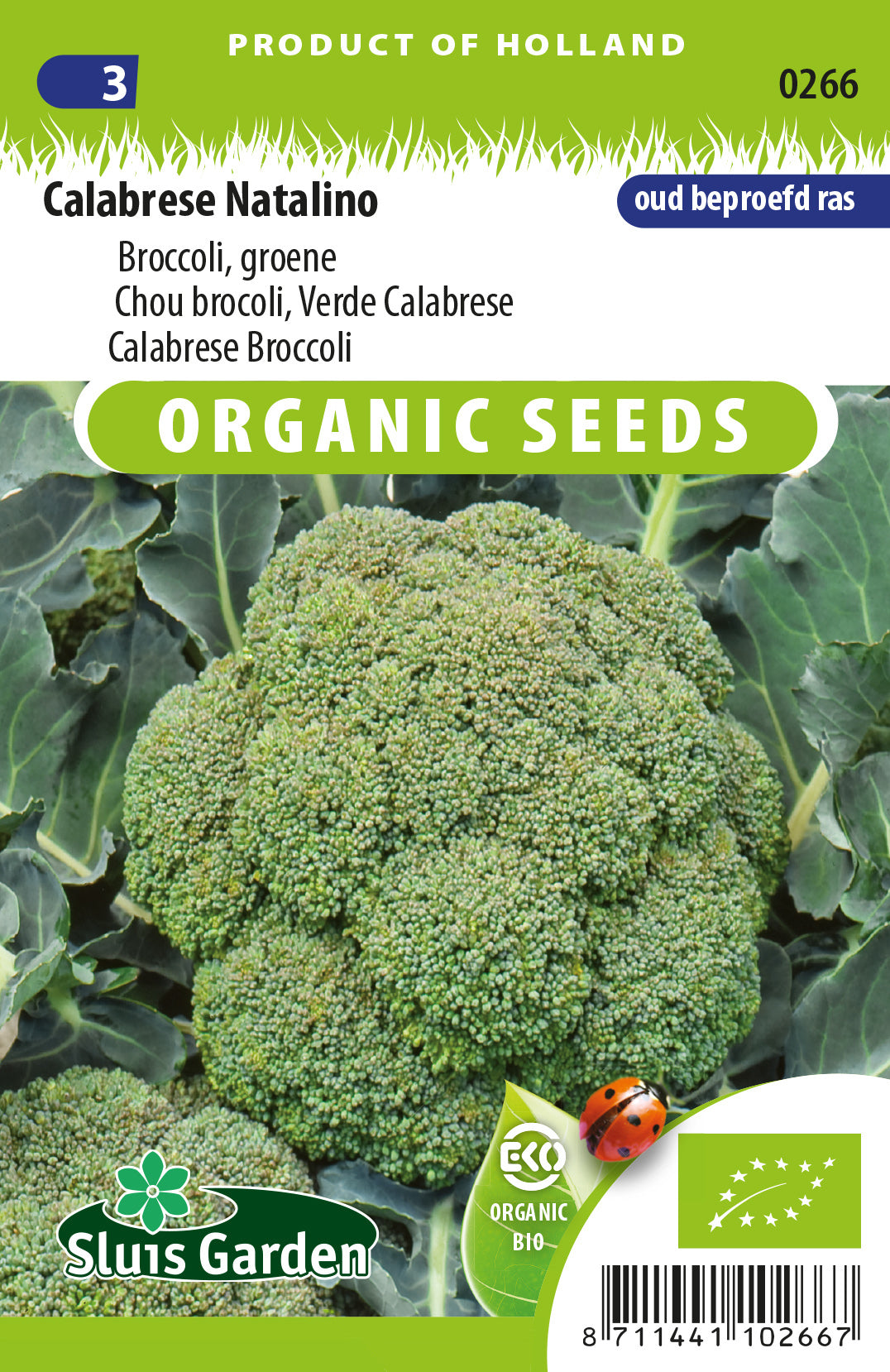1
/
of
1
Calabrese Broccoli Natalino BIO
Calabrese Broccoli Natalino BIO
Regular price
1.350 KWD
Regular price
Sale price
1.350 KWD
Unit price
/
per
Shipping calculated at checkout.
Couldn't load pickup availability
Growing Calabrese Broccoli "Natalino" organically involves following natural and sustainable practices without the use of synthetic chemicals. Here's a step-by-step guide to help you grow organic broccoli:
**1. Soil Preparation:**
- Choose well-draining soil with a slightly acidic to neutral pH. Amend the soil with organic matter, such as compost or well-rotted manure, to enhance fertility and structure.
**2. Planting:**
- **Timing:** Broccoli is a cool-season crop. Start seeds indoors 6-8 weeks before the last expected frost or directly sow seeds in early spring or late summer/early fall.
- **Spacing:** Plant broccoli transplants or thin seedlings to allow about 18-24 inches between plants. Space rows about 24-36 inches apart.
**3. Watering:**
- Keep the soil consistently moist. Water deeply and regularly, especially during dry periods. Broccoli needs consistent moisture for proper head development.
**4. Mulching:**
- Apply organic mulch, such as straw or shredded leaves, around the plants to conserve soil moisture, suppress weeds, and regulate soil temperature.
**5. Fertilization:**
- Use organic fertilizers, such as compost or well-rotted manure, to provide nutrients to the soil.
- Side-dress with compost or a balanced organic fertilizer during the growing season to supply additional nutrients.
**6. Companion Planting:**
- Planting broccoli near other crops that can help deter pests can be beneficial. Consider companion plants like marigolds, basil, or dill.
**7. Pest Control:**
- Monitor for pests like aphids, cabbage worms, and flea beetles. Handpick pests when possible, or use natural predators like beneficial insects.
- Neem oil or insecticidal soap can be used as organic alternatives for pest control.
**8. Disease Prevention:**
- Practice good crop rotation to prevent soil-borne diseases.
- Adequate spacing and good air circulation help reduce the risk of fungal diseases.
**9. Harvesting:**
- Harvest broccoli heads when they are firm and compact before the buds start to open. Cut the main head with a sharp knife, leaving some stem for regrowth.
- Side shoots (secondary heads) will often develop after the main head is harvested, providing additional harvests.
**10. Successive Planting:**
- For a prolonged harvest, consider successive plantings every few weeks.
**11. Saving Seeds:**
- If you plan to save broccoli seeds for future planting, allow some plants to bolt (go to seed) at the end of the season. The seeds can be collected once they have matured.
**12. Organic Certification:**
- If you wish to officially label your broccoli as organic, follow the guidelines and requirements set by your local organic certification body.
Growing organic Calabrese Broccoli "Natalino" involves creating a healthy and sustainable environment for your plants, promoting biodiversity, and minimizing the use of synthetic inputs. Following these practices will contribute to the overall well-being of your garden and the quality of your broccoli harvest.
**1. Soil Preparation:**
- Choose well-draining soil with a slightly acidic to neutral pH. Amend the soil with organic matter, such as compost or well-rotted manure, to enhance fertility and structure.
**2. Planting:**
- **Timing:** Broccoli is a cool-season crop. Start seeds indoors 6-8 weeks before the last expected frost or directly sow seeds in early spring or late summer/early fall.
- **Spacing:** Plant broccoli transplants or thin seedlings to allow about 18-24 inches between plants. Space rows about 24-36 inches apart.
**3. Watering:**
- Keep the soil consistently moist. Water deeply and regularly, especially during dry periods. Broccoli needs consistent moisture for proper head development.
**4. Mulching:**
- Apply organic mulch, such as straw or shredded leaves, around the plants to conserve soil moisture, suppress weeds, and regulate soil temperature.
**5. Fertilization:**
- Use organic fertilizers, such as compost or well-rotted manure, to provide nutrients to the soil.
- Side-dress with compost or a balanced organic fertilizer during the growing season to supply additional nutrients.
**6. Companion Planting:**
- Planting broccoli near other crops that can help deter pests can be beneficial. Consider companion plants like marigolds, basil, or dill.
**7. Pest Control:**
- Monitor for pests like aphids, cabbage worms, and flea beetles. Handpick pests when possible, or use natural predators like beneficial insects.
- Neem oil or insecticidal soap can be used as organic alternatives for pest control.
**8. Disease Prevention:**
- Practice good crop rotation to prevent soil-borne diseases.
- Adequate spacing and good air circulation help reduce the risk of fungal diseases.
**9. Harvesting:**
- Harvest broccoli heads when they are firm and compact before the buds start to open. Cut the main head with a sharp knife, leaving some stem for regrowth.
- Side shoots (secondary heads) will often develop after the main head is harvested, providing additional harvests.
**10. Successive Planting:**
- For a prolonged harvest, consider successive plantings every few weeks.
**11. Saving Seeds:**
- If you plan to save broccoli seeds for future planting, allow some plants to bolt (go to seed) at the end of the season. The seeds can be collected once they have matured.
**12. Organic Certification:**
- If you wish to officially label your broccoli as organic, follow the guidelines and requirements set by your local organic certification body.
Growing organic Calabrese Broccoli "Natalino" involves creating a healthy and sustainable environment for your plants, promoting biodiversity, and minimizing the use of synthetic inputs. Following these practices will contribute to the overall well-being of your garden and the quality of your broccoli harvest.
Share

